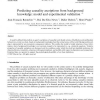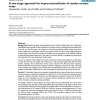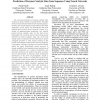282 search results - page 40 / 57 » On predicting secondary structure transition |
IJAR
2008
13 years 7 months ago
2008
A model is defined that predicts an agent's ascriptions of causality (and related notions of facilitation and justification) between two events in a chain, based on backgroun...
CP
2003
Springer
14 years 25 days ago
2003
Springer
In this paper, we present an algorithm to propagate an n-ary constraint (with n greater than 2) specifying the relative positions of points in a three-dimensional rigid group. The ...
BMCBI
2007
13 years 7 months ago
2007
Background: MicroRNAs (miRNAs) are recognized as one of the most important families of noncoding RNAs that serve as important sequence-specific post-transcriptional regulators of ...
BMCBI
2006
13 years 7 months ago
2006
Background: Protein topology representations such as residue contact maps are an important intermediate step towards ab initio prediction of protein structure. Although improvemen...
CIBCB
2007
IEEE
13 years 11 months ago
2007
IEEE
The accurate prediction of enzyme catalytic sites remains an open problem in bioinformatics. Recently, several structure-based methods have become popular; however, few robust seq...



